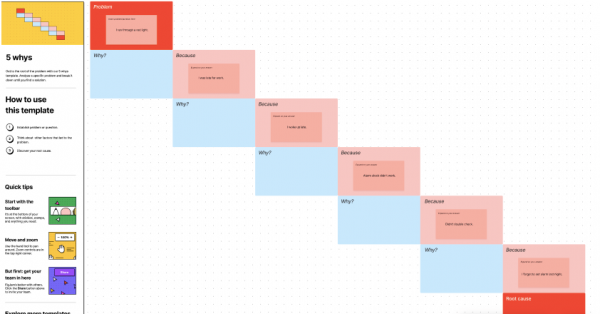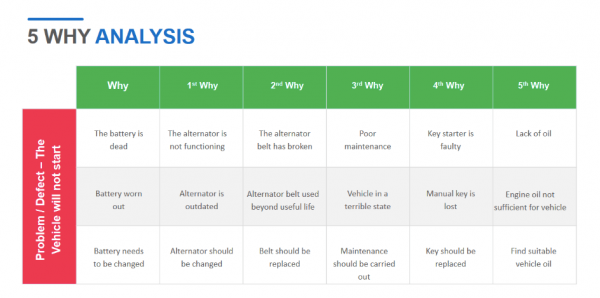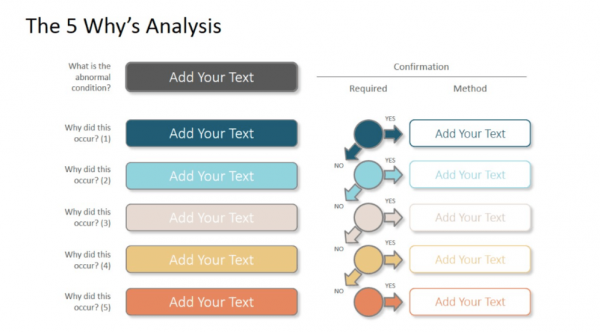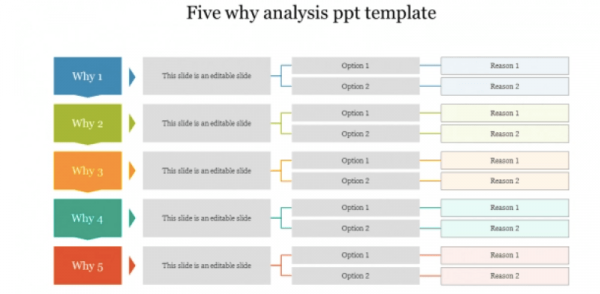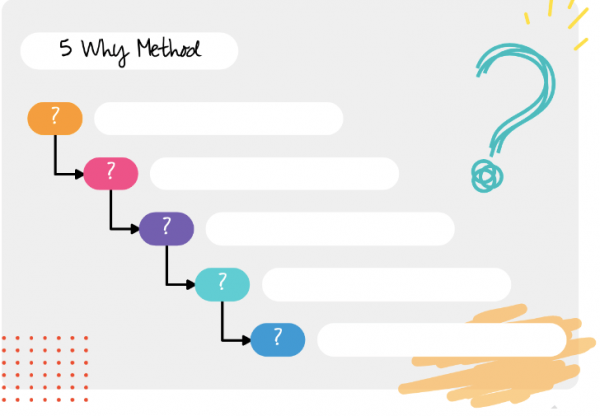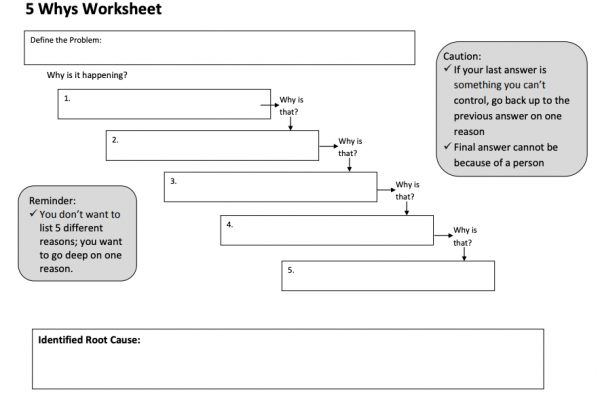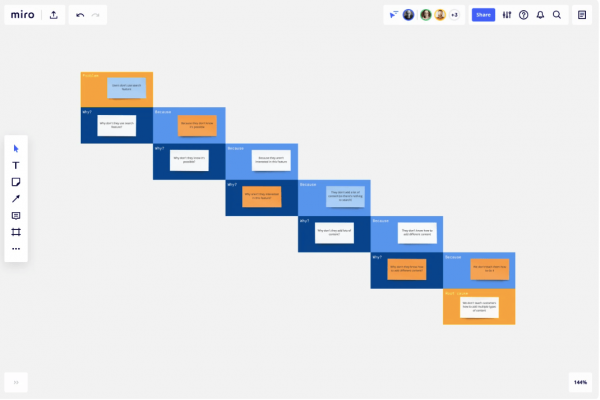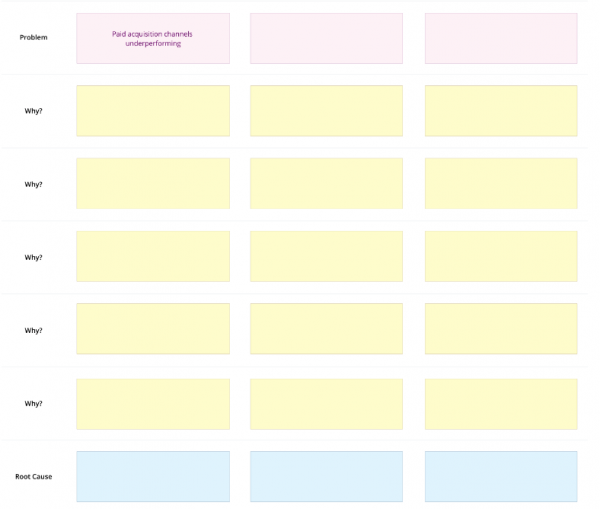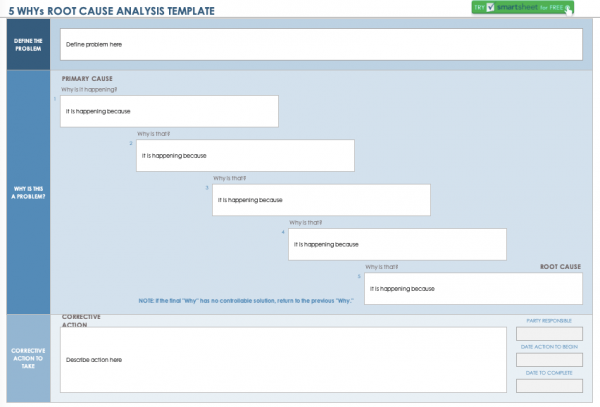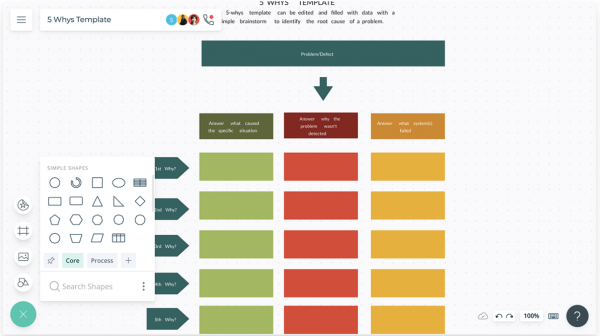What is a 5 Why Analysis?
5 why analysis is a tool used to look at the root cause of a problem. It is predicated on the idea that five root causes for any issue must be found and treated. It aims to identify the problem’s underlying causes so they may be adequately addressed and fixed.
It is a straightforward but effective method that significantly impacts problem-solving. But it’s essential to remember that it’s just one tool in a wide variety available for problem-solving and investigation. It can be a potent tool for solving complicated problems if appropriately utilized.
To find the source of a problem, you must ask “Why?” five times. The first four times, you search for the problem’s immediate causes. The fifth time, you’re trying to identify the underlying cause.
Its beauty is that it is simple and easy to use. It can be used by anyone, anywhere, at any time.
- What is a 5 Why Analysis?
- Uses of 5 Why Analysis
- Guidelines to be followed:
- 5 Why Analysis Examples
- Why and When to Do the 5 Why Analysis
- How to do 5 Why Analysis
- Finding the issue
- 1. Why did the problem occur?
- 2. Why was the employee not adequately trained on safety procedures?
- 3. Why was the employee's supervisor not adequately trained on safety procedures?
- 4. Why doesn't the company have a formal training program for safety?
- 5. Why has the company not made safety a priority?
- Determining the Root Cause
- Difference between 5 Why Analysis and a Fishbone Diagram
- Advantages of 5 Why Analysis
- Limitations of 5 Why Analysis
- FAQs
Uses of 5 Why Analysis
It is used for understanding the problem better so its root causes can be identified and solved.
It also allows for developing countermeasures and preventive measures to avoid similar problems from occurring in the future.
It can be utilized as a tool for problem-solving and continuous improvement.
It can also be used to investigate accidents and incidents so that the root causes can be identified and addressed.
Guidelines to be followed:
1. Start with the problem or issue that needs to be addressed.
2. Ask “Why?” five times, each answer providing the basis for the next question.
3. Try to get to the root cause of the problem with the fifth “Why?” This may require some creative thinking and out-of-the-box thinking.
4. Once the root cause has been identified, develop a plan of action to address it.
5 Why Analysis Examples
Example 1
A machine in a production process is not working correctly
The first why might be because there is a build-up of material on the machine.
The second why might be because the material is not being removed quickly enough.
The third why might be because the conveyor belt is not moving the material fast enough.
The fourth why might be because the motor that drives the conveyor belt is not working correctly.
The fifth why might be because the motor is not receiving enough power.
The course of action here is to fix the motor to receive enough power.
Example 2
Problem: A newly installed vending machine is not working
Why? The vending machine is not receiving power.
Why? The power cord is not working.
Why? The power cord was not correctly installed.
Why? The power cord was not installed by a qualified technician.
Why? There is a shortage of qualified technicians.
Action plan: Train more technicians in how to properly install power cords.
Why and When to Do the 5 Why Analysis
In lean thinking, the 5 why method explores the cause-and-effect relationships underlying a particular problem. It aims to determine a problem’s root cause by asking why it repeatedly occurred until a fundamental cause is reached. This method is helpful in problem-solving because it can help identify problems that may not be immediately apparent.
The method is often used with lean tools, such as value stream mapping and root cause analysis. These tools can help organizations identify and eliminate waste in their processes when used together.
The best situation to use it is while attempting to identify the underlying cause of a current issue. It can also be used in a more thorough problem-solving procedure to help spark ideas for improvement.
The methods that can be employed to solve problems are numerous. Nevertheless, this particular analysis is a proper technique since it compels you to dig past the obvious and seek out the root of a problem.
How to do 5 Why Analysis
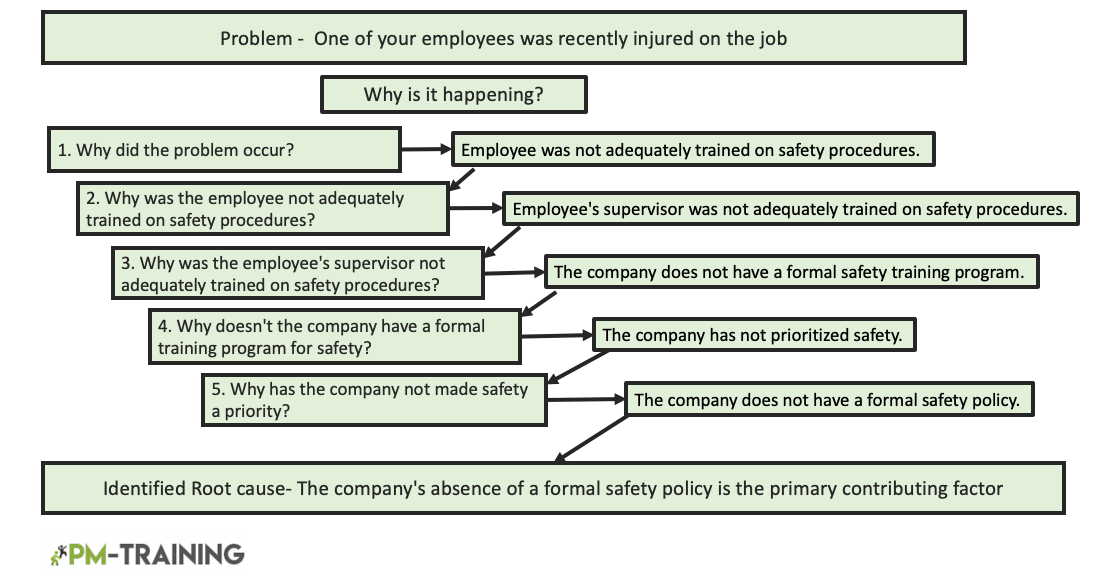
You are the manager of a manufacturing plant. One of your employees was recently injured on the job. After investigating the incident, you discover that the employee was not following proper safety procedures. To prevent this type of accident from happening again in the future, you decide to conduct a five why analysis.
Finding the issue
The issue, in this case, is that an employee sustained an injury at work.
1. Why did the problem occur?
You may ask: Why was the employee not following proper safety procedures? The answer could be that the employee was not adequately trained on safety procedures.
2. Why was the employee not adequately trained on safety procedures?
The answer could be that the employee’s supervisor was not adequately trained on safety procedures.
3. Why was the employee’s supervisor not adequately trained on safety procedures?
The answer could be that the company does not have a formal safety training program.
4. Why doesn’t the company have a formal training program for safety?
The answer could be that the company has not prioritized safety.
5. Why has the company not made safety a priority?
The answer could be that the company does not have a formal safety policy.
Determining the Root Cause
You have discovered the problem’s underlying cause by asking why five times. In this instance, the company’s absence of a formal safety policy is the primary contributing factor. You can take action to stop the issue from happening again once you have determined its underlying cause. In this case, you may decide to create a formal safety policy.
Difference between 5 Why Analysis and a Fishbone Diagram
A fishbone diagram is used to brainstorm potential root causes of an issue, whereas a five why analysis is used to determine the root cause of a problem.
While a five why analysis is frequently used for recurring problems, a fishbone diagram may be used for any situation. Therefore, a five why analysis is more of an investigating tool, but a fishbone diagram is more of a brainstorming tool.
A five why analysis is more verbal, whereas a fishbone graphic is more visual. This is so that the probable reasons for a problem can be represented by a fishbone diagram using images and symbols instead of a five why analysis using words and sentences.
A fishbone diagram is typically used by a team of people because it requires input from multiple people to be effective, while in the five why analysis, one person usually conducts research.
Advantages of 5 Why Analysis
The method’s main advantage is that it can help identify the root cause of a problem rather than simply addressing its symptoms. This can lead to more effective and efficient solutions.
It can be used as a preventative measure to identify potential problems before they occur, saving time and resources.
It is also easy to use. This ensures that everyone from senior management to front-line workers can participate in the problem-solving process.
The technique can be valuable for problem-solving and quality improvement.
Limitations of 5 Why Analysis
The Analysis can be time-consuming and may require the involvement of multiple people.
It may not always be clear what the root cause of a problem is. Multiple root causes may be identified in some cases, making it difficult to find a single cause.
This technique may not be suitable for all types of problems. For example, it is not always possible to identify a problem’s root cause if an external factor causes it, for example, whether or where there is insufficient information.
FAQs
How do you use the 5 why analysis template?
Finding the issue is the first step. When an issue has been recognized, you must ask five times why it happened before determining its underlying cause.
When should you use the 5 why analysis?
When an issue needs to be solved, but the cause of the problem is unknown, it is most frequently used. It can also be applied to future problem prevention.
Are the 5 why analysis and fishbone diagram the same? If not, what is the difference?
No, the fishbone diagram is used to brainstorm potential reasons for an issue, whereas the five why analysis is used to identify the problem’s root cause.
What problems can be solved using the 5 why analysis?
It can be used to solve a variety of problems, such as; finding the root cause of a problem, preventing a problem from occurring in the future, and improving a process.

